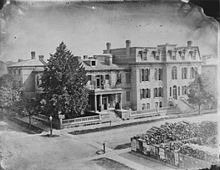 Family Stories
Family Stories
» Show All «Prev «1 ... 3 4 5 6 7 8 9 10 11 ... 44» Next» » Slide Show
1837 Mr. Cawthra’s Bags of Gold
In the 1820s and 1830s, Joseph Cawthra was a stalwart of anti-government politics in York. Although Cawthra was a leading merchant, his attitude towards the Bank of Upper Canada was for a long time consistent with his politics. In evidence given to the House of Assembly’s select committee on the state of the provincial currency in 1830, he decried its privileged position as the only chartered bank in the colony and advocated a more competitive financial market. On this occasion he declared that he had never been a director or stockholder of the bank. Later that year, however, he acquired his first shares in the bank, possibly in order to stand as an “anti-establishment” candidate for its directorate. This was the background to his controversial role in shoring up the Bank of Upper Canada during the financial crisis of May and June 1837.

Bank of Upper Canada
The suspension of payment in specie by banks in the United States set off a run on banks in the Canadas. The situation in Toronto was aggravated by William Lyon Mackenzie’s newspaper campaign against the banks, in which he urged his readers to cash in their banknotes and withdraw their deposits in specie. On 17 May Mackenzie reported that Cawthra had visited all the banks in town the day before in order to cash in notes. Cawthra retorted that he had deposited more than £1,000 in the Bank of Upper Canada on that day and had a total of £15,000 deposited there. Francis Hincks, the cashier of the Bank of the People, then swore an affidavit that William Cawthra, Joseph’s right hand in his business, had cashed £600 of that bank’s paper on the 16th and had declared his intention of cashing in paper at the city’s other banks, including the Bank of Upper Canada. Joseph replied with an affidavit that he had deposited a large sum in the Bank of Upper Canada on the 16th and had withdrawn none since.
At the end of June, he had to make a public denial of the rumour that his £15,000 was deposited under a private arrangement which precluded the bank from applying it to the payment of other obligations. It seems likely that, on 16 May, the Cawthras had withdrawn specie from the Bank of the People, and perhaps from other Toronto banks, in order to shore up the Bank of Upper Canada. One might expect Mackenzie to have vilified them for doing so, and it is perhaps a measure of Joseph’s prestige in reform circles that Mackenzie made excuses for the Cawthras instead, repeatedly acknowledging Joseph’s long years of devotion to the reform cause and ascribing his conduct to necessity. Cawthra, explained Mackenzie, had £30,000 or more, including his deposits, tied up in the Bank of Upper Canada and was therefore compelled to defend the institution against his better judgment.1.
William Gooderham’s eldest daughter, Louisa Score, remembered the stirring times of the rebellion of 1837. She spent a great part of her early life in a house that stood on the site of the present distillery. “During the rebellion, Mrs. Score said, the old mill was used for hiding articles of value, and was utilized by Mr. Cawthra for hiding his bags of gold.2.

1.Excerpt from Paul Romney, “CAWTHRA, JOSEPH,” in Dictionary of Canadian Biography, vol. 7, University of Toronto/Université Laval, 2003–, accessed February 13, 2017, http://www.biographi.ca/en/bio/cawthra_joseph_7E.html.
2. Excerpt from an obituary from 1908 for Louisa Score.
1837 Mr. Cawthra's Bags of Gold
According to Louisa Gooderham Walker Score, during the rebellion, the mill was used to store articles of value and “Mr. Cawthra’s bags of gold”
| Owner of original | GG |
| Date | 10 Jan 2019 |
| Linked to | The Distillery, Toronto, ON, Canada; Louisa Gooderham |
» Show All «Prev «1 ... 3 4 5 6 7 8 9 10 11 ... 44» Next» » Slide Show
